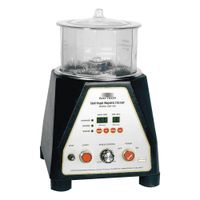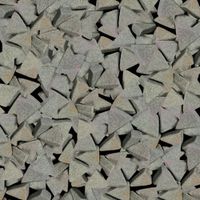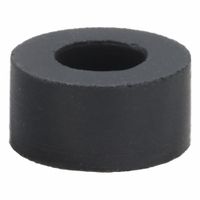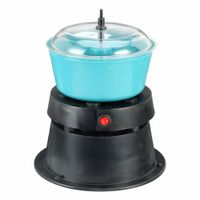Call +(254) 703 030 000 / 751 483 999 / 721 704 777
.....Read More
Frequently Asked Questions
What is vibratory tumbling and finishing?
Vibratory tumbling and finishing is a mass finishing process used to deburr, clean, polish, and improve the surface finish of parts. Parts are placed in a vibratory finishing machine along with media (abrasive or non-abrasive) and a compound. The machine vibrates, causing the parts and media to rub against each other, which removes material and refines the surface. This process is versatile and can be used on a wide range of materials and part sizes, from small intricate components to larger, more robust items. It's often chosen for its ability to process many parts simultaneously, making it a cost-effective solution for improving the quality and appearance of manufactured goods.
How does vibratory tumbling work?
Vibratory tumbling is a mass finishing process used to deburr, clean, polish, and finish parts. It works by placing parts in a vibratory finishing machine, which is typically a bowl-shaped or tub-shaped container. Along with the parts, an abrasive media and a liquid compound (often water-based with detergents or rust inhibitors) are added to the machine.
The machine then vibrates, creating a relative motion between the parts and the media. This constant movement causes the media to rub against the parts, removing sharp edges, smoothing surfaces, and improving the overall finish. The vibration can be controlled in terms of amplitude and frequency to achieve different finishing results. The liquid compound helps to keep the media and parts clean, lubricates the process, and can also aid in the finishing action.
The key to vibratory tumbling's effectiveness is the continuous and even contact between the media and all surfaces of the parts, which is achieved through the constant vibratory motion. This process is versatile and can be used on a wide range of materials and part sizes, from small intricate components to larger, more robust items.
What types of materials can be processed with vibratory tumbling?
Vibratory tumbling is a versatile finishing process suitable for a wide range of materials. Metals such as steel, aluminum, brass, copper, and titanium are commonly processed for deburring, polishing, and surface improvement. Plastics, including acrylic, nylon, and ABS, can be tumbled to remove rough edges and achieve a smooth finish. Ceramics and glass are also compatible, often for rounding edges or preparing surfaces for further treatment. Additionally, rubber and even wood can undergo vibratory tumbling for specific finishing requirements. The choice of media and compounds depends on the material and desired outcome, making vibratory tumbling adaptable to diverse industrial applications.
What is the difference between vibratory tumbling and centrifugal magnetic finishing?
Vibratory tumbling and centrifugal magnetic finishing are both surface finishing processes, but they differ significantly in their mechanisms and applications.
Vibratory tumbling, also known as vibratory finishing, involves placing parts in a tub or bowl along with abrasive media, water, and compounds. The tub vibrates, causing the media and parts to rub against each other. This creates a gentle scrubbing action that deburrs, cleans, polishes, and burnishes the surfaces. It's a versatile process suitable for a wide range of materials and part sizes, often used for mass finishing, deburring, and radius generation on parts.
Centrifugal magnetic finishing, on the other hand, utilizes tiny stainless steel pins (media) in a rotating magnetic field. The magnetic force propels these pins against the parts, which are also placed in a container with water and compounds. This high-speed, high-energy action provides a very fine, detailed finish, reaching intricate geometries and internal features that other methods might miss. It's particularly effective for deburring and polishing small, delicate, or complex parts, such as those found in medical devices, jewelry, and aerospace components, where a smooth, precise finish is critical.
In essence, vibratory tumbling offers a broad, general-purpose finishing solution through a more gentle, mass action, while centrifugal magnetic finishing provides a highly precise, aggressive, and detailed finish for intricate and sensitive parts.
What types of media are used in vibratory tumbling?
Vibratory tumbling, a mass finishing process, utilizes various types of media to achieve different surface finishes on workpieces. The choice of media depends on the desired outcome, whether it's deburring, polishing, cleaning, or surface preparation.
Common types of media include: * **Ceramic media:** These are typically made from aluminum oxide, silicon carbide, or zirconia. They are highly durable and come in various shapes (cones, cylinders, spheres, triangles) and sizes. Ceramic media are excellent for aggressive deburring, radiusing, and general finishing of harder metals.
* **Plastic media:** Composed of polyester or urea resins, plastic media are softer than ceramic media. They are ideal for delicate parts, pre-plate finishing, and achieving a smoother, more refined surface. They are also effective for deburring softer metals like aluminum or brass.
* **Steel media:** Made from hardened stainless steel, these media are non-abrasive and used for polishing, burnishing, and producing a bright, reflective finish. They are very dense and last a long time, often used with steel shot for a mirror-like shine.
* **Organic media:** These are typically made from corn cob, walnut shells, or wood. They are soft and used for drying, light polishing, and cleaning delicate parts. Corn cob is excellent for drying, while walnut shells can provide a gentle abrasive action.
* **Synthetic media:** These are engineered media designed for specific applications, often containing abrasive particles within a resin binder. They offer a balance between aggressiveness and finish quality.The shape and size of the media are also crucial. Larger media remove material faster, while smaller media can reach into intricate geometries. The overall effectiveness of vibratory tumbling depends on the correct combination of media type, size, shape, and the chosen tumbling compound.
How do finishing compounds enhance the tumbling process?
Finishing compounds play a crucial role in enhancing the tumbling process, which is used to deburr, clean, polish, and improve the surface finish of various parts. These compounds are typically liquid or powder concentrates that are mixed with water to create a solution. Their primary functions include lubrication, cleaning, and chemical action.
Lubrication is essential to prevent parts from scratching or damaging each other during the tumbling process. The compounds create a film that reduces friction, allowing the parts to slide smoothly against one another and the media. This also helps to prevent media from embedding in softer materials.
Cleaning is another vital function. Finishing compounds contain detergents and surfactants that help to remove oils, grease, dirt, and other contaminants from the part surfaces. They also help to keep the tumbling media clean and prevent the redeposition of removed material back onto the parts.
Furthermore, many finishing compounds have chemical actions that contribute to the desired surface finish. For example, some compounds contain mild acids or alkalis that can etch or brighten the surface, while others may contain rust inhibitors to prevent corrosion. Certain compounds are formulated to assist in specific processes like burnishing, which compresses the surface to improve hardness and luster. By optimizing these factors, finishing compounds significantly improve the efficiency and effectiveness of the tumbling process, leading to higher quality finished parts.
What are the benefits of using vibratory tumblers for deburring?
Vibratory tumblers offer several key benefits for deburring, a process crucial for removing sharp edges or burrs from machined parts. Firstly, they provide a consistent and uniform finish across all parts, regardless of their size or shape. The continuous vibratory action ensures that all surfaces are exposed to the media, leading to a more even deburring than manual methods. Secondly, vibratory tumblers are highly efficient and can process a large volume of parts simultaneously, significantly reducing labor costs and processing time compared to hand deburring. This efficiency makes them ideal for high-volume manufacturing environments. Thirdly, they are versatile, accommodating a wide range of part materials and sizes, from small intricate components to larger, heavier parts. The media used can also be customized to achieve specific surface finishes, from gentle deburring to aggressive material removal. Finally, vibratory tumblers are relatively simple to operate and require minimal training, contributing to lower operational costs. They also offer a safer alternative to manual deburring, reducing the risk of injuries associated with handling sharp parts. These advantages make vibratory tumbling a cost-effective and efficient solution for achieving high-quality deburred parts.
How do you choose the right media for vibratory tumbling?
Choosing the right media for vibratory tumbling depends on several factors, including the material of the parts, the desired surface finish, and the specific application (e.g., deburring, polishing, cleaning).
For deburring and aggressive material removal, ceramic media is often a good choice. It's durable and comes in various shapes and grits to tackle different part geometries and burr sizes. Plastic media is softer and less abrasive, making it suitable for delicate parts, pre-polishing, or achieving a smoother finish without significant material removal. Stainless steel media is very durable and heavy, ideal for burnishing, achieving high-gloss finishes, or processing very hard materials. It also doesn't wear down, preventing dust.
Other considerations include the media shape (e.g., cones, cylinders, spheres, pyramids), which affects how it interacts with the part's contours, and the media size, which must be appropriate to avoid lodging in holes or features. The type of compound used in the tumbling process also plays a crucial role in achieving the desired results. It's often recommended to test different media types and sizes with a small batch of parts to determine the most effective combination for your specific needs.
What maintenance is required for vibratory tumblers?
Vibratory tumblers require regular maintenance to ensure optimal performance and longevity. Key maintenance tasks include:1. **Cleaning:** Regularly clean the bowl and media to prevent buildup of grime and residue, which can affect the tumbling process and media effectiveness.
2. **Media Replacement:** Tumbling media wears down over time and should be replaced when it becomes too small, ineffective, or contaminated.
3. **Lubrication:** Check and lubricate the motor bearings and other moving parts according to the manufacturer's recommendations to reduce friction and prevent premature wear.
4. **Belt Tension (if applicable):** For belt-driven models, periodically check and adjust the belt tension to ensure proper power transfer and prevent slippage.
5. **Vibration Inspection:** Inspect the vibratory mechanism for any signs of wear, looseness, or unusual noises. Address any issues promptly to maintain consistent vibration.
6. **Drainage:** Ensure the drainage system (if present) is clear and functioning correctly to prevent fluid buildup.
7. **Electrical Checks:** Periodically inspect electrical connections and cords for damage or wear.Following these maintenance steps will help keep your vibratory tumbler operating efficiently and extend its lifespan.
How long does the vibratory tumbling process typically take?
Please provide the question you would like me to answer.





